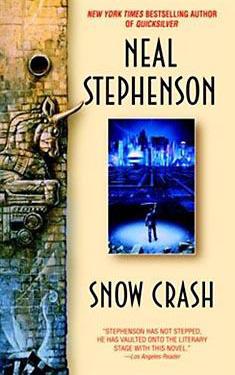Neal Stephenson
Completed 10/31/2014, Reviewed 11/1/2014
2 stars
Life happened after reading about 100 pages of this
book. My partner of 10 years decided to
leave me. This probably tainted my
opinion of “Snow Crash”. I was already
having a hard time concentrating on anything, and I just wanted to explode out
of my skin. But rather than finding
solace in reading, all the things about this book that were supposed to be great
felt self-conscious and arrogant. This
book came out in the 1992. So perhaps I
needed a more 90’s sardonic mind-set, with less distraction by real life events
that made this book feel like an exercise in narcissism.
“Snow Crash” takes place in a dystopian future where the
government has broken down and the country is organized and run by franchises
of former entities: the CIA/Library of
Congress conglomerate known as the CIC, Mr. Lee’s Greater Hong Kong, Bob’s
Police Security, and Uncle Enzo’s Mafia franchise of pizza delivery
chains. The protagonist, Hiro
Protagonist (yeah, talk about narcissistic choice), is a hacker who co-created
a virtual universe used by millions of computer users. By day, he lives in a storage unit, delivers
pizza for the Mafia, practices sword fighting with his katanas, and mines data
for the CIC. After crashing the Mafia
car on a nearly failed attempt to deliver a pizza in 30 minutes, he retreats to
his Metaverse, where he discovers a computer virus that destroying the minds of
other hackers. Called Snow Crash, the
virus practically destroys his former hacker partner, sending our Hiro on a
mission to destroy the virus and its creators.
The one thing I liked about the book was that the concept of
the virus was based on Sumerian mythology.
I found myself trudging through the narrative, waiting for more
discussion of the gods and the myth of the Tower of Babel
I was really confused by the timeline of the story. Time passes but feels unaccounted for,
creating gaps in the development of the relationships in the story. The secondary character, the 15 year old
skateboarding Kourier named Y.T., which stands for Yours Truly (another ugh),
is introduced when she gets Hiro’s pizza to its destination after he crashes
his car. From that point on, they become
friends, with her eventually helping Hiro with his mission, and getting into
trouble on her own as well. Somewhere in
there, this relationship developed, but I have no idea where. Towards the end of the book, Hiro reflects on
all the times he spent with Y.T., but I don’t remember any of that
development.
I liked a lot of the concepts of the book. The Metaverse is an interesting prediction of
the now ubiquitous MMORPGs like Second Life and World of Warcraft. However, reading it over 20 years after
publication feels like the book is nothing more than “a guy and his MMORPG
character”, not unlike Stephenson’s later book “The Diamond Age”, which I
loved, being dated enough to be reduced to a story about a girl and her
tablet.
The dystopian organization of the remnants of the U.S. was pretty
interesting too, creating the environment for the bad guys to take over the
world via Snow Crash and the Sumerian mythology. But eventually, this felt derivative or
perhaps like a deconstruction of a Robert Ludlum spy novel where some
unassuming guy foils the megalomaniac.
Perhaps I need to reread this book again in a few
years. Given a return to normalcy in my
life, I might have a more open mind for this darling of science fiction fans
and literary critics alike. But it made
me trepidatious about taking on Stephenson’s massive tomes like “Anathem”. I give this book 2 stars, with the right to
re-review sometime in the future when my own perspective is perhaps a little
more tolerant.

No comments:
Post a Comment